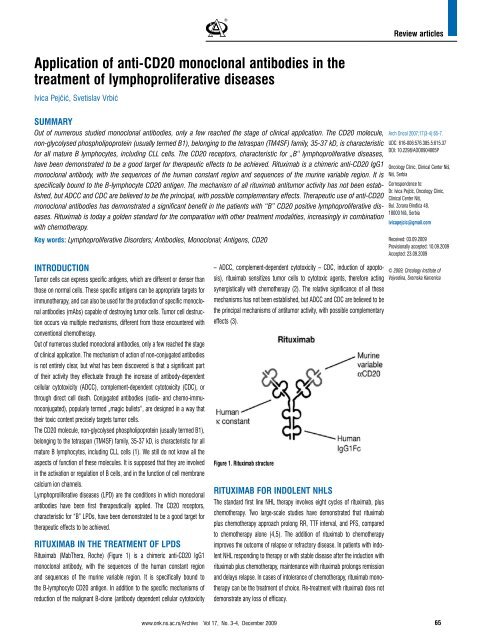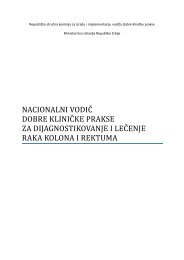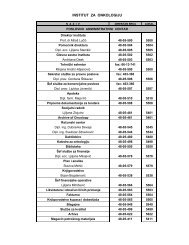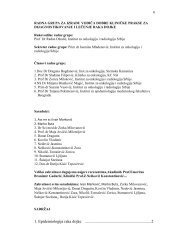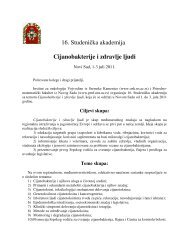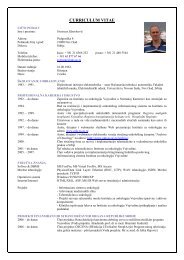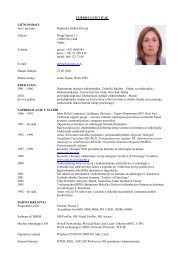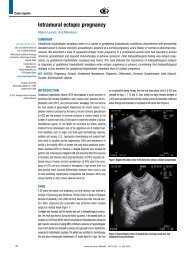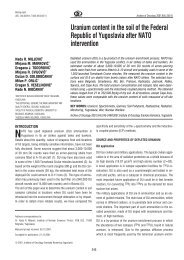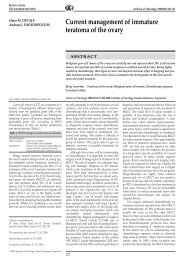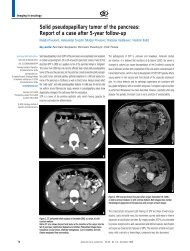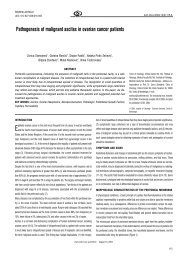Application of anti-CD20 monoclonal antibodies in the ... - doiSerbia
Application of anti-CD20 monoclonal antibodies in the ... - doiSerbia
Application of anti-CD20 monoclonal antibodies in the ... - doiSerbia
You also want an ePaper? Increase the reach of your titles
YUMPU automatically turns print PDFs into web optimized ePapers that Google loves.
®<br />
Review articles<br />
<strong>Application</strong> <strong>of</strong> <strong>anti</strong>-<strong>CD20</strong> <strong>monoclonal</strong> <strong>anti</strong>bodies <strong>in</strong> <strong>the</strong><br />
treatment <strong>of</strong> lymphoproliferative diseases<br />
Ivica Pejčić, Svetislav Vrbić<br />
SUMMARY<br />
Out <strong>of</strong> numerous studied <strong>monoclonal</strong> <strong>anti</strong>bodies, only a few reached <strong>the</strong> stage <strong>of</strong> cl<strong>in</strong>ical application. The <strong>CD20</strong> molecule,<br />
non-glycolysed phospholipoprote<strong>in</strong> (usually termed B1), belong<strong>in</strong>g to <strong>the</strong> tetraspan (TM4SF) family, 35-37 kD, is characteristic<br />
for all mature B lymphocytes, <strong>in</strong>clud<strong>in</strong>g CLL cells. The <strong>CD20</strong> receptors, characteristic for „B“ lymphoproliferative diseases,<br />
have been demonstrated to be a good target for <strong>the</strong>rapeutic effects to be achieved. Rituximab is a chimeric <strong>anti</strong>-<strong>CD20</strong> IgG1<br />
<strong>monoclonal</strong> <strong>anti</strong>body, with <strong>the</strong> sequences <strong>of</strong> <strong>the</strong> human constant region and sequences <strong>of</strong> <strong>the</strong> mur<strong>in</strong>e variable region. It is<br />
specifically bound to <strong>the</strong> B-lymphocyte <strong>CD20</strong> <strong>anti</strong>gen. The mechanism <strong>of</strong> all rituximab <strong>anti</strong>tumor activity has not been established,<br />
but ADCC and CDC are believed to be <strong>the</strong> pr<strong>in</strong>cipal, with possible complementary effects. Therapeutic use <strong>of</strong> <strong>anti</strong>-<strong>CD20</strong><br />
<strong>monoclonal</strong> <strong>anti</strong>bodies has demonstrated a significant benefit <strong>in</strong> <strong>the</strong> patients with “B” <strong>CD20</strong> positive lymphoproliferative diseases.<br />
Rituximab is today a golden standard for <strong>the</strong> comparation with o<strong>the</strong>r treatment modalities, <strong>in</strong>creas<strong>in</strong>gly <strong>in</strong> comb<strong>in</strong>ation<br />
with chemo<strong>the</strong>rapy.<br />
Arch Oncol 2007;17(3-4):65-7.<br />
UDC: 616-006:576.385.5:615.37<br />
DOI: 10.2298/AOO0904065P<br />
Oncology Cl<strong>in</strong>ic, Cl<strong>in</strong>ical Center Niš,<br />
Niš, Serbia<br />
Correspondence to:<br />
Dr. Ivica Pejčić, Oncology Cl<strong>in</strong>ic,<br />
Cl<strong>in</strong>ical Center Niš,<br />
Bul. Zorana Ð<strong>in</strong>đića 48,<br />
18000 Niš, Serbia<br />
ivicapejcic@gmail.com<br />
Key words: Lymphoproliferative Disorders; Antibodies, Monoclonal; Antigens, <strong>CD20</strong><br />
Received: 03.09.2009<br />
Provisionally accepted: 10.09.2009<br />
Accepted: 23.09.2009<br />
INTRODUCTION<br />
Tumor cells can express specific <strong>anti</strong>gens, which are different or denser than<br />
those on normal cells. These specific <strong>anti</strong>gens can be appropriate targets for<br />
immuno<strong>the</strong>rapy, and can also be used for <strong>the</strong> production <strong>of</strong> specific <strong>monoclonal</strong><br />
<strong>anti</strong>bodies (mAbs) capable <strong>of</strong> destroy<strong>in</strong>g tumor cells. Tumor cell destruction<br />
occurs via multiple mechanisms, different from those encountered with<br />
conventional chemo<strong>the</strong>rapy.<br />
Out <strong>of</strong> numerous studied <strong>monoclonal</strong> <strong>anti</strong>bodies, only a few reached <strong>the</strong> stage<br />
<strong>of</strong> cl<strong>in</strong>ical application. The mechanism <strong>of</strong> action <strong>of</strong> non-conjugated <strong>anti</strong>bodies<br />
is not entirely clear, but what has been discovered is that a significant part<br />
<strong>of</strong> <strong>the</strong>ir activity <strong>the</strong>y effectuate through <strong>the</strong> <strong>in</strong>crease <strong>of</strong> <strong>anti</strong>body-dependent<br />
cellular cytotoxicity (ADCC), complement-dependent cytotoxicity (CDC), or<br />
through direct cell death. Conjugated <strong>anti</strong>bodies (radio- and chemo-immunoconjugated),<br />
popularly termed „magic bullets“, are designed <strong>in</strong> a way that<br />
<strong>the</strong>ir toxic content precisely targets tumor cells.<br />
The <strong>CD20</strong> molecule, non-glycolysed phospholipoprote<strong>in</strong> (usually termed B1),<br />
belong<strong>in</strong>g to <strong>the</strong> tetraspan (TM4SF) family, 35-37 kD, is characteristic for all<br />
mature B lymphocytes, <strong>in</strong>clud<strong>in</strong>g CLL cells (1). We still do not know all <strong>the</strong><br />
aspects <strong>of</strong> function <strong>of</strong> <strong>the</strong>se molecules. It is supposed that <strong>the</strong>y are <strong>in</strong>volved<br />
<strong>in</strong> <strong>the</strong> activation or regulation <strong>of</strong> B cells, and <strong>in</strong> <strong>the</strong> function <strong>of</strong> cell membrane<br />
calcium ion channels.<br />
Lymphoproliferative diseases (LPD) are <strong>the</strong> conditions <strong>in</strong> which <strong>monoclonal</strong><br />
<strong>anti</strong>bodies have been first <strong>the</strong>rapeutically applied. The <strong>CD20</strong> receptors,<br />
characteristic for “B” LPDs, have been demonstrated to be a good target for<br />
<strong>the</strong>rapeutic effects to be achieved.<br />
Rituximab <strong>in</strong> <strong>the</strong> treatment <strong>of</strong> LPDs<br />
Rituximab (MabThera, Roche) (Figure 1) is a chimeric <strong>anti</strong>-<strong>CD20</strong> IgG1<br />
<strong>monoclonal</strong> <strong>anti</strong>body, with <strong>the</strong> sequences <strong>of</strong> <strong>the</strong> human constant region<br />
and sequences <strong>of</strong> <strong>the</strong> mur<strong>in</strong>e variable region. It is specifically bound to<br />
<strong>the</strong> B-lymphocyte <strong>CD20</strong> <strong>anti</strong>gen. In addition to <strong>the</strong> specific mechanisms <strong>of</strong><br />
reduction <strong>of</strong> <strong>the</strong> malignant B-clone (<strong>anti</strong>body dependent cellular cytotoxicity<br />
– ADCC, complement-dependent cytotoxicity – CDC, <strong>in</strong>duction <strong>of</strong> apoptosis),<br />
rituximab sensitizes tumor cells to cytotoxic agents, <strong>the</strong>refore act<strong>in</strong>g Vojvod<strong>in</strong>a, Sremska Kamenica<br />
© 2009, Oncology Institute <strong>of</strong><br />
synergistically with chemo<strong>the</strong>rapy (2). The relative significance <strong>of</strong> all <strong>the</strong>se<br />
mechanisms has not been established, but ADCC and CDC are believed to be<br />
<strong>the</strong> pr<strong>in</strong>cipal mechanisms <strong>of</strong> <strong>anti</strong>tumor activity, with possible complementary<br />
effects (3).<br />
Figure 1. Rituximab structure<br />
Rituximab for <strong>in</strong>dolent NHLs<br />
The standard first l<strong>in</strong>e NHL <strong>the</strong>rapy <strong>in</strong>volves eight cycles <strong>of</strong> rituximab, plus<br />
chemo<strong>the</strong>rapy. Two large-scale studies have demonstrated that rituximab<br />
plus chemo<strong>the</strong>rapy approach prolong RR, TTF <strong>in</strong>terval, and PFS, compared<br />
to chemo<strong>the</strong>rapy alone (4,5). The addition <strong>of</strong> rituximab to chemo<strong>the</strong>rapy<br />
improves <strong>the</strong> outcome <strong>of</strong> relapse or refractory disease. In patients with <strong>in</strong>dolent<br />
NHL respond<strong>in</strong>g to <strong>the</strong>rapy or with stable disease after <strong>the</strong> <strong>in</strong>duction with<br />
rituximab plus chemo<strong>the</strong>rapy, ma<strong>in</strong>tenance with rituximab prolongs remission<br />
and delays relapse. In cases <strong>of</strong> <strong>in</strong>tolerance <strong>of</strong> chemo<strong>the</strong>rapy, rituximab mono<strong>the</strong>rapy<br />
can be <strong>the</strong> treatment <strong>of</strong> choice. Re-treatment with rituximab does not<br />
demonstrate any loss <strong>of</strong> efficacy.<br />
www.onk.ns.ac.rs/Archive Vol 17, No. 3-4, December 2009<br />
65
Review articles<br />
Rituximab for aggressive NHLs<br />
Aggressive NHLs require, which is <strong>the</strong> current standard, eight cycles <strong>of</strong> rituximab<br />
plus CHOP chemo<strong>the</strong>rapy. The improvement <strong>of</strong> overall survival <strong>in</strong> <strong>the</strong><br />
GELA LNH-98.5 study was <strong>of</strong> such a magnitude that statistical significance was<br />
achieved after only 12 months <strong>of</strong> follow-up (6). The benefit was ma<strong>in</strong>ta<strong>in</strong>ed for<br />
as long as 4 years, which confirmed <strong>the</strong> superiority <strong>of</strong> <strong>the</strong> comb<strong>in</strong>ed treatment.<br />
These results were later confirmed by <strong>the</strong> M<strong>in</strong>T study (7). The results compelled<br />
many to try to <strong>in</strong>vestigate <strong>the</strong> significance <strong>of</strong> rituximab addition to chemo<strong>the</strong>rapy<br />
<strong>in</strong> <strong>the</strong> second l<strong>in</strong>e approach. Numerous studies have demonstrated that rituximab<br />
is able to potentiate <strong>the</strong> response to <strong>the</strong>rapy and, thus, disease outcome<br />
as well, especially for <strong>the</strong> patients suitable for HDT/ASCT. Studies are on <strong>the</strong> way<br />
aim<strong>in</strong>g to def<strong>in</strong>e <strong>the</strong> role <strong>of</strong> rituximab for aggressive NHL relapses.<br />
Rituximab for mantle cell lymphoma (MCL)<br />
Patients with MCL on conventional <strong>the</strong>rapy have poor prognosis. The role <strong>of</strong><br />
rituximab and chemo<strong>the</strong>rapy comb<strong>in</strong>ation rema<strong>in</strong>s controversial <strong>in</strong> that regard.<br />
However, <strong>the</strong> comb<strong>in</strong>ation <strong>of</strong> rituximab and chemo<strong>the</strong>rapy and/or HDT/ASCT<br />
demonstrates a certa<strong>in</strong> progress. In some randomized trials, <strong>the</strong> comb<strong>in</strong>ation<br />
<strong>of</strong> CHOP and rituximab (R-CHOP) was significantly better regard<strong>in</strong>g <strong>the</strong> OR<br />
(p=0.0054) and CR (p=0.00024). However, <strong>the</strong> impact on TTF was much<br />
smaller (P=0.0131), while regard<strong>in</strong>g PFS and OS <strong>the</strong>re was no progress (8).<br />
However, <strong>the</strong> data produced by functional imag<strong>in</strong>g (FI) suggest that <strong>the</strong> quality<br />
<strong>of</strong> early remission is significant, recommend<strong>in</strong>g a new strategy <strong>of</strong> HDT/ASCR<br />
<strong>the</strong>rapy (9). In <strong>the</strong> study OSHO#39, <strong>the</strong> comb<strong>in</strong>ation <strong>of</strong> R-MCP (mitoxantrone,<br />
chlorambucil, prednisolone) was not superior to MCP chemo<strong>the</strong>rapy<br />
alone. The conclusion can be drawn that immunochemo<strong>the</strong>rapy is not a<br />
mandatory option for this entity with poor prognosis (10). The European MCL<br />
Network has stressed that immunochemo<strong>the</strong>rapy resulted <strong>in</strong> high RRs <strong>in</strong> two<br />
prospective <strong>in</strong>ternational trials (MCL elderly and MCL younger). Fur<strong>the</strong>r <strong>in</strong>vestigation<br />
will determ<strong>in</strong>e <strong>the</strong> role <strong>of</strong> rituximab <strong>in</strong> <strong>the</strong> ma<strong>in</strong>tenance <strong>the</strong>rapy (11).<br />
Rituximab for CLL<br />
In recent years, none <strong>of</strong> <strong>the</strong> cl<strong>in</strong>ical trials has demonstrated any survival<br />
advantage <strong>of</strong> various chemo<strong>the</strong>rapy regimens. Never<strong>the</strong>less, some new<br />
agents possess <strong>the</strong> potential to overcome this barrier. First, it has been shown<br />
that rituximab 500 mg/m 2 added to chemo<strong>the</strong>rapy improves overall survival<br />
compared to chemo<strong>the</strong>rapy alone (serv<strong>in</strong>g as a history control) (12). The best<br />
results were observed <strong>in</strong> a group <strong>of</strong> patients demonstrat<strong>in</strong>g molecular remission<br />
<strong>of</strong> <strong>the</strong> disease (MRD). Then, a phase III study CLL8 was designed, which<br />
demonstrated that rituximab 500 mg/m 2 plus chemo<strong>the</strong>rapy significantly<br />
improves PFS compared to chemo<strong>the</strong>rapy alone as <strong>the</strong> first l<strong>in</strong>e <strong>of</strong> treatment<br />
(13). PFS was improved <strong>in</strong> patients with 17p deletion and unmutated IgVH as<br />
well, o<strong>the</strong>rwise be<strong>in</strong>g <strong>the</strong> groups with very poor prognosis (14). The studies<br />
<strong>of</strong> alternative comb<strong>in</strong>ations such as rituximab plus bendamust<strong>in</strong>e as <strong>the</strong> first<br />
l<strong>in</strong>e approach are on <strong>the</strong> way, and <strong>the</strong> results <strong>of</strong> first <strong>in</strong>terim analysis <strong>of</strong> <strong>the</strong><br />
CLL 208 study, with chlorambucil added to rituximab, are eagerly awaited for.<br />
New <strong>anti</strong>-<strong>CD20</strong> <strong>anti</strong>bodies<br />
A group <strong>of</strong> new <strong>anti</strong>-<strong>CD20</strong> <strong>monoclonal</strong> „second generation“ <strong>anti</strong>bodies, is <strong>in</strong><br />
<strong>the</strong> phase <strong>of</strong> pre-cl<strong>in</strong>ical and cl<strong>in</strong>ical <strong>in</strong>vestigation. Atumubab is a IgG1 <strong>anti</strong>body<br />
with some characteristics <strong>of</strong> type I <strong>anti</strong>bodies, mean<strong>in</strong>g that when it b<strong>in</strong>ds to<br />
<strong>CD20</strong> it <strong>in</strong>duces its own translocation <strong>in</strong>to a detergent-<strong>in</strong>soluble layer, which is<br />
associated with complement activation and CDC type <strong>of</strong> elim<strong>in</strong>ation <strong>of</strong> tumor<br />
cells. In contrast to rituximab, it has a full human sequence and it b<strong>in</strong>ds to <strong>the</strong><br />
epitope, which is <strong>in</strong> a more compact way bound to <strong>the</strong> cell membrane with<br />
prolonged action (15). Ofatumomab is a subject <strong>of</strong> numerous cl<strong>in</strong>ical trials.<br />
One <strong>of</strong> <strong>the</strong> segments is a phase I/II study <strong>of</strong> <strong>the</strong> patients with recurrent follicular<br />
lymphomas (16). Its toxicity is similar to <strong>the</strong> toxicity <strong>of</strong> rituximab, and responses<br />
have been achieved even <strong>in</strong> patients on rituximab treatment. The CDC effect has<br />
been observed <strong>in</strong> CLL too <strong>in</strong> phase I/II studies. In o<strong>the</strong>r studies, <strong>the</strong> patients<br />
with disease progression on fludarab<strong>in</strong>e and alemtuzumab have been analyzed.<br />
Veltuzumab (hA20) is a humanized IgG1 <strong>monoclonal</strong> <strong>anti</strong>body target<strong>in</strong>g <strong>the</strong><br />
identical epitope as rituximab (17). The results are similar to <strong>the</strong> ones rituximab<br />
achieves, but with lower dosage than rituximab. GA101 is a type II <strong>anti</strong>body,<br />
generated, similar to many o<strong>the</strong>rs, <strong>in</strong> <strong>the</strong> Ch<strong>in</strong>ese hamster ovary (CHO) cells.<br />
This <strong>anti</strong>body, <strong>in</strong> addition to <strong>the</strong> ADCC mechanism, has <strong>the</strong> properties <strong>in</strong>creas<strong>in</strong>g<br />
<strong>the</strong> apoptosis-<strong>in</strong>duced activity (18). AME-133 is a human IgG1 <strong>anti</strong>body with<br />
high aff<strong>in</strong>ity for <strong>CD20</strong> and <strong>the</strong> ability to b<strong>in</strong>d to CD16 via its Fc region, effectuat<strong>in</strong>g<br />
5 to 10 times higher aff<strong>in</strong>ity than rituximab (19). Precl<strong>in</strong>ical <strong>in</strong>vestigations<br />
have demonstrated also a larger effect upon <strong>the</strong> NK-cell activation. Special<br />
benefit from this will perhaps have <strong>the</strong> patients with a suboptimal status <strong>of</strong><br />
immune effector cells. The common elements <strong>of</strong> this new group <strong>of</strong> <strong>monoclonal</strong><br />
<strong>anti</strong>bodies (<strong>in</strong>clud<strong>in</strong>g PRO 131921 as well) are that <strong>the</strong>se are all human/humanized<br />
<strong>anti</strong>-<strong>CD20</strong> <strong>monoclonal</strong> <strong>anti</strong>bodies designed to b<strong>in</strong>d to new epitopes, that<br />
<strong>the</strong>y <strong>in</strong>crease ADCC, CDC, b<strong>in</strong>d<strong>in</strong>g to <strong>CD20</strong>, or apoptosis activation.<br />
Radioimmuno<strong>the</strong>rapy<br />
Radioimmuno<strong>the</strong>rapy <strong>in</strong>volves <strong>the</strong> adm<strong>in</strong>istration <strong>of</strong> <strong>anti</strong>bodies labeled with a<br />
radioisotope, enabl<strong>in</strong>g <strong>the</strong> destruction <strong>of</strong> cells present<strong>in</strong>g <strong>the</strong> target <strong>anti</strong>gen,<br />
but also <strong>the</strong> adjacent cells, which do not express enough <strong>anti</strong>gens to b<strong>in</strong>d<br />
<strong>the</strong> <strong>anti</strong>body. The concept was <strong>in</strong>troduced by De Nardo et al. HLA <strong>anti</strong>gens<br />
on <strong>the</strong> cells <strong>of</strong> aggressive non-Hodgk<strong>in</strong> lymphomas were <strong>the</strong> first target,<br />
utiliz<strong>in</strong>g radio-labeled <strong>anti</strong>bodies aga<strong>in</strong>st Lym-1 and achiev<strong>in</strong>g sporadic<br />
complete remissions (20). Nowadays, two radioconjugates target<strong>in</strong>g <strong>CD20</strong><br />
are available, Yttrium-90 ( 90 Y)-labeled IBRUTUMOMAB TIUXETAN (Zeval<strong>in</strong>,<br />
Cell Therapeutics) and Iod<strong>in</strong>e-131 ( 131 J)-labeled TOZITUMOMAB (Bexxar,<br />
GlaxoSmithKl<strong>in</strong>e). They are approved for <strong>the</strong> patients with relapsed/recurrent<br />
follicular or low-evolutionary lymphomas (21).<br />
CONCLUSION<br />
Therapeutic use <strong>of</strong> <strong>anti</strong>-<strong>CD20</strong> <strong>monoclonal</strong> <strong>anti</strong>bodies has demonstrated a<br />
significant benefit <strong>in</strong> <strong>the</strong> patients with lymphoproliferative diseases. Rituximab<br />
is today a golden standard for <strong>the</strong> comparison with o<strong>the</strong>r treatment modalities,<br />
<strong>in</strong>creas<strong>in</strong>gly <strong>in</strong> comb<strong>in</strong>ation with chemo<strong>the</strong>rapy. New <strong>anti</strong>-<strong>CD20</strong> agents<br />
provide both potentially higher activity characteristic for rituximab and different<br />
targets, creat<strong>in</strong>g <strong>the</strong> possibility to be comb<strong>in</strong>ed with rituximab. New<br />
prospective cl<strong>in</strong>ical studies, especially with patients refractory to rituximab,<br />
will provide appropriate answers to <strong>the</strong>se questions. Radiolabeled <strong>anti</strong>bodies<br />
can prove to be useful <strong>in</strong> patients resistant to rituximab.<br />
Conflict <strong>of</strong> <strong>in</strong>terest<br />
We declare no conflicts <strong>of</strong> <strong>in</strong>terest.<br />
REFERENCES<br />
1 Matutes E, Polliack A. Morphological and immunophenotypic features <strong>of</strong> chronic<br />
lymphocytic leukemia. Rev Cl<strong>in</strong> Exp Hematol. 2000;4:22-47.<br />
66<br />
www.onk.ns.ac.rs/Archive Vol 17, No. 3-4, December 2009
Review articles<br />
2 Alas S, Emmanouilides C, Bonavida B. Inhibition <strong>of</strong> <strong>in</strong>terleuk<strong>in</strong> 10 by rituximab<br />
results <strong>in</strong> downregulation <strong>of</strong> bcl-2 and sensitization <strong>of</strong> B-cell non-Hodgk<strong>in</strong>´s lymphoma<br />
to apoptosis. Cl<strong>in</strong> Cancer Res. 2001;7:709-23.<br />
3 Zhou X, Q<strong>in</strong> X. The role <strong>of</strong> complement <strong>in</strong> <strong>the</strong> mechanism <strong>of</strong> action <strong>of</strong> rituximab for<br />
B-cell lymphoma: implications for <strong>the</strong>rapy. Oncologist. 2008;13:954-66.<br />
4 Marcus R, Imrie K, Belch A. M39021-an <strong>in</strong>ternational multicentre, randomized,<br />
open-label phase III trial compar<strong>in</strong>g rituximab added to CVP chemo<strong>the</strong>rapy to chemo<strong>the</strong>rapy<br />
alone <strong>in</strong> untreated stage III/IV follicular non-Hodgk<strong>in</strong>'s lymphoma: f<strong>in</strong>al<br />
analysis. Blood. 2003;102:28a.<br />
5 Hiddemann W, Dreyl<strong>in</strong>g MH, Forstpo<strong>in</strong>ter R. Comb<strong>in</strong>ed immunochemo<strong>the</strong>rapy<br />
(R-CHOP) significantly improves time to treatment failure <strong>in</strong> first-l<strong>in</strong>e <strong>the</strong>rapy<br />
<strong>of</strong> follicular lymphoma: results <strong>of</strong> a prospective randomized trial <strong>of</strong> <strong>the</strong> German<br />
LowGrade Lymphoma Study Group (GLSG). Blood. 2003;102:104a.<br />
6 C<strong>of</strong>fier B, Herbrecht R, Morel P. GELLA study compar<strong>in</strong>g CHOP and R-CHOP <strong>in</strong><br />
elderly patients with DLCL: 3-year median follow up with an analysis accord<strong>in</strong>g to<br />
co-morbidity factors. Hematol J. 2003;Suppl 2:111.<br />
7 Pfreundschuh M, Trümper L, Österborg A, Pettengell R, Trneny M, Shepherd L, et<br />
al. Randomized <strong>in</strong>tergroup trial <strong>of</strong> first l<strong>in</strong>e treatment for patients


